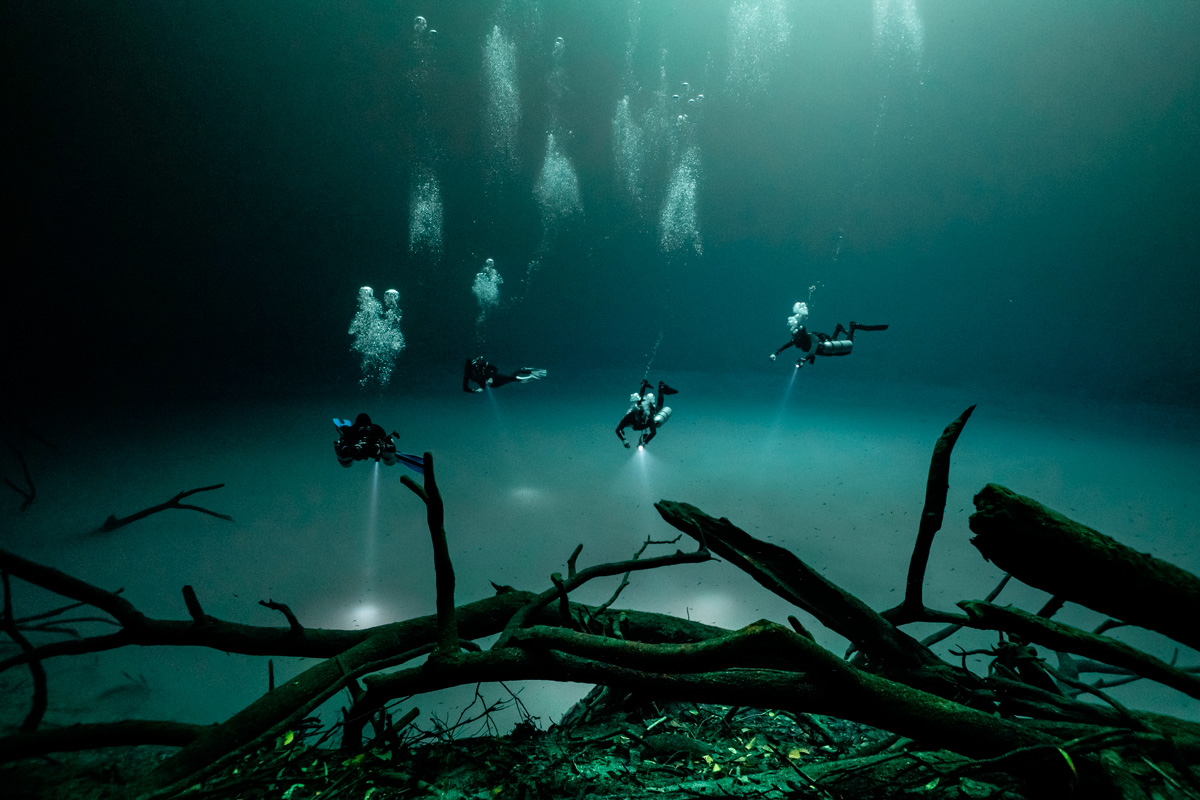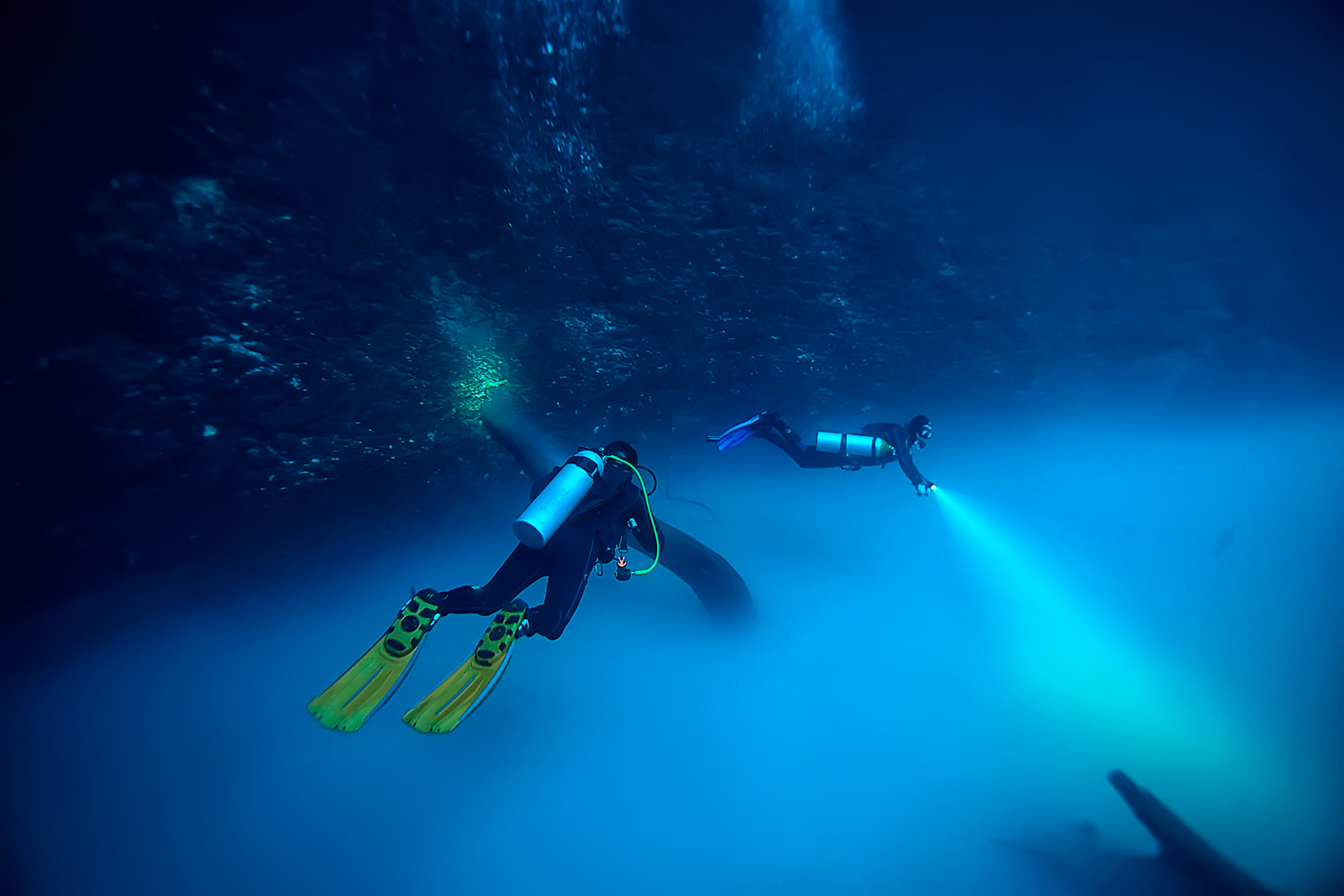Somewhere, deep in the jungle…
Mexico’s Yucatan Peninsula (and nearby Cozumel) have been among of the world’s most famous dive destinations since the sport began in earnest in the late 1950s and 1960s. Before divers arrived, the area was a cluster of small fishing communities until 1961. That all changed when Jacques Cousteau told the world he had found one of the most beautiful snorkeling and scuba diving areas.
Today, divers who visit Cancun, Playa Del Carmen, or Cozumel are treated not only to the world’s second-largest barrier reef with some of the clearest ocean water and abundant underwater wildlife, but they’re also within a short distance of world-class cave and cavern diving – and nearly any certified scuba diver can explore it the underwater world here.
While it rains about 55 inches a year in Playa Del Carmen, you won’t find any rivers here to help the water make its way to the ocean. Instead, the water soaks through a porous limestone shelf and flows in underground rivers. This river system – the Sac Actun (“White Cave”) – in the Yucatán Peninsula wanders for 95 miles through a maze of underground limestone caves. The filtered water is exceptionally clear and maintains a constant temperature of about 77 degrees F year-round.
The river isn’t that far underground – it runs just meters below the surface. Over time, in a few locations, the “ceiling” over the river has collapsed, leaving a cenoté, or sinkhole, giving ancient cultures and modern explorers access to this amazing underground cave system. One of those locations is Cenoté Angelita (“Little Angel”). It’s here, 17km from Tulum, that a dense, green forest opens up to reveal a 200-foot round hole that plunges down almost as deep.

A small dock at Cenote Angelita makes entries and exits easy.
There are many beautiful cenotes in the region that divers regularly explore. Some of the most beautiful and popular include Dos Ojos, Chac Mool, and Ponderosa, and experienced certified cave divers often explore great distances through the cave system beginning at these sites. Less experienced divers can visit and dive many of these cenotes, following their guide along a line on short excursions through the caverns. Technically speaking, the dives for recreationally-certified divers are considered cavern dives, where natural sunlight can always be seen during the dive and there’s always an open ascent if the need arises.
Cenote Angelita
What makes Angelita most unique is due to what’s both there, and what’s not there.
While most cenotes are entryways to the underwater cave system and allow recreational divers to enter and explore the vast underwater cave system, Angelita is essentially a single open pit – a single sheer-walled shaft that runs almost straight down to a depth of nearly 200 feet. Unlike most other cenotes in the area, Cenote Angelita has no connection to other cenotes.
So why dive into a vertical hole in the ground instead of exploring a beautiful cave system with stalagmites? It has to do with the gas – and we’re not talking about the air in your tank.

Diving Angelita
As you begin to descend into the cenote, the water is somewhat hazy for the first 20-30 feet or so, caused by organic material falling into the cenote from the surrounding jungle. Below this, the 77-degree F water clears up and below you can see what remains of the limestone ceiling that collapsed, and the remains of ancient trees on top of it. At 89 feet down, it looks like a small underwater island, surrounded by a mysterious white fog surrounding it. It gives the site a bit of an eerie feeling, and knowing the ancient Mayan people considered the cenote sacred, using them to celebrate religious rites (including violent human sacrifices), brings even more mystery to this unique dive site.
At 99 feet, just below the level of the submerged island, divers reach this foggy layer, which is actually a layer of hydrogen sulfide gas. The gas was formed by the decaying vegetation that has fallen into the Cenote, rotting at depth, and produced the white gassy layer that hangs in the water. It is a poisonous gas, but breathing air from your tank will not affect you. The hydrogen sulfide has a very sulfurous smell which is pretty much like rotten eggs, and you’ll definitely notice this smell as you get near it.

4 divers prepare to descend through the layer of hydrogen sulfide gas. Photo: Marianna Tombini SS
The gas layer is about 12 feet thick, and descending through this gas is a unique experience in itself. You’ll go from crystal-clear water into a dense fog where visibility drops to near zero. It’s important to monitor your depth gauge to be sure you’re descending through it, and ascending upwards when going the other direction. Along with the layer of gas, you will experience a halocline (where fresh and saltwater meet), so your vision will be blurry – something often experienced in other cenotes. Because it’s further from the sea, the saltwater layer starts much deeper than other cenotes near Tulum.

After passing below this layer of hydrogen sulfide gas, visibility is much better, but it’s noticeably darker than above. Due to the depth of over 100 feet, your dive time here is limited, and most guides will bring you up back through it after exploring below the fog for a few minutes where you will repeat the experience once again. Having a light is essential here (ideally two, so you have a backup), both to help you see below the cloud layer, and also for the second part of the dive, where you’ll be exploring the walls and a few small caverns on your way back up.
After ascending above the cloud, your guide will lead you in a circle around the cave, exploring the sheer walls, while slowly ascending. Because it’s a deep dive, you’ll need to ascend slowly and make a safety stop at 15 feet before surfacing.
Who can dive here?
Access to Cenote Angelita is easy – there’s a park-like picnic area, short trails leading to the site, and a wood dock that makes entries and exits easy. To get access, you will need to dive with a local dive guide and pay the entrance fee of $300mx (about $18 USD). If you bring a camera, it’s an additonal fee.
The diving itself is relatively easy, with warm water, excellent visibility (above the fog), and no currents to deal with. The depth of 110 feet + does make this a dive for more advanced divers who are comfortable and have training diving to these depths. Divers should also be comfortable managing the limited visibility they will experience at depth, have good buoyancy control, and be able to manage a safe ascent, including a safety stop – and potentially a decompression stop if needed. Needless to say, diving with a computer is essential.
Diving Cenote Angelita is a very unique experience that every diver should have on their bucket list. If you’re staying on Cozumel, it’s relatively to take the early morning ferry over to Playa Del Carmen and spend the day diving 2 different cenotes and return by dinner. If you’re staying in Cancun or Playa Del Carmen, it’s just as easy – and definitely worth it.

A small gift shop, restrooms, and snack bar at Cenote Angelita
Do you have a favorite place to dive in Mexico? A favorite dive shop, boat, or resort? Drop us a line and we’ll pay them a visit on our next trip!
